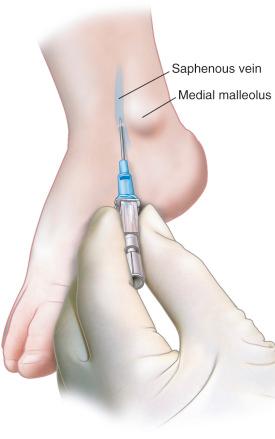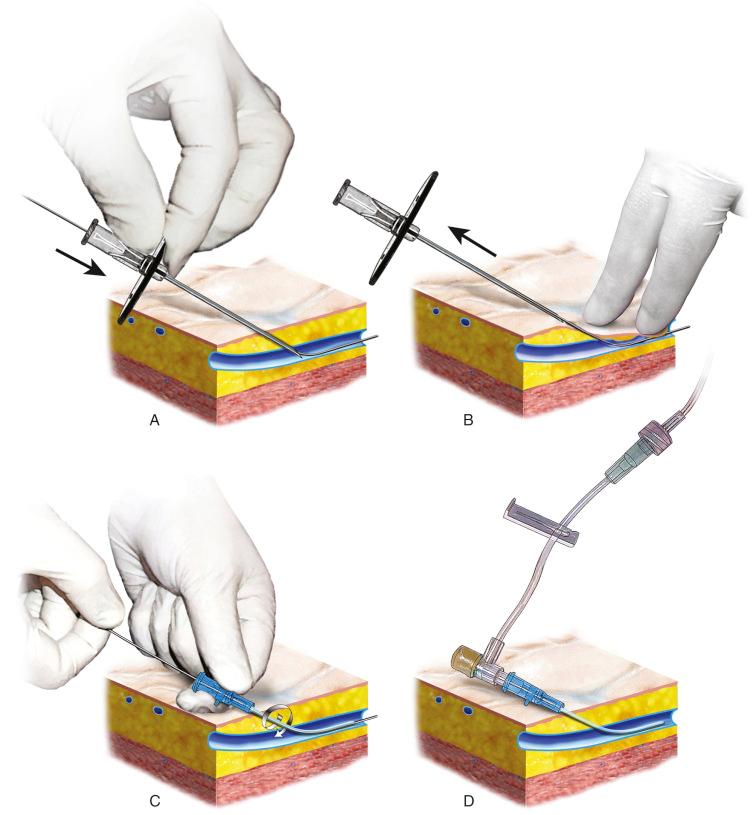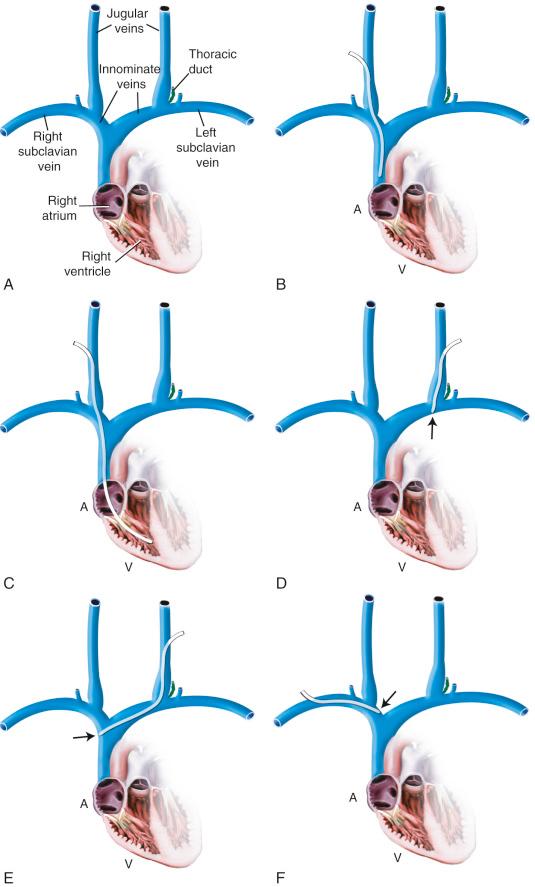Physical Address
304 North Cardinal St.
Dorchester Center, MA 02124
VASCULAR CANNULATION IS AN IMPORTANT PROCEDURE in the anesthetic and perioperative management of children. Its routine use was introduced in the 1950s. The indications are to provide routes to administer fluids, drugs, and blood products, monitor cardiopulmonary function, and access blood for laboratory testing. Although establishing vascular access may be extremely difficult at times, especially in the very young or small child, no child should be denied an indicated procedure because of an operator's inability to access the vascular system; appropriate consultation should be sought as necessary. Regardless of the procedure or the person in whom the procedure is attempted, gloves should be worn to maintain clean or sterile technique and to protect health care professionals from exposure to blood and sharps. An update from the Pediatric Perioperative Cardiac Arrest Registry suggests that lack of good vascular access may contribute to an underestimation of the fluid requirement or blood loss and inadequate replacement of fluid or blood in anesthetized children, thus underscoring the importance of appropriate and adequate vascular access and monitoring.
Percutaneous intravenous (IV) access should be present in almost all anesthetized children for the following reasons :
To provide a route for postoperative pain management.
To administer drugs, fluids and electrolytes, glucose, and blood products, including resuscitation medications.
To measure central venous pressure; the accuracy of this measurement does not vary according to the location of the catheter but does depend on ensuring direct continuity between the central and peripheral circulation. This can be assessed by providing a large, sustained inspiration or occluding the venous return of the extremity, which both cause an increase in the peripheral pressure. Hypothermia may impair the accuracy of such measurements.
Alcohol pads or chlorhexidine swabs
Gloves
Tourniquet
Gauze
Clear plastic dressing (Tegaderm, 3M Medical-Surgical Division, St. Paul, MN, or OpSite, Smith & Nephew, Inc., Largo, FL)
Tape
Arm board
Consider the possible need for latex-free equipment. In cases of difficult access, the availability of a transillumination light source (Karl Storz, 485 B Type, Tuttlingen, Germany) may improve the success rate of catheter placement. Ultrasonography also may be used to obtain peripheral venous access at the basilic, cephalic, or brachial veins. Finally, new near-infrared and infrared technology is available to aid in the identification of peripheral veins (AccuVein, AccuVein, Inc., Huntington, NY; VeinViewer, Christie Digital Systems, Cypress, CA).
Awake IV line placement can be facilitated by any combination of good patient rapport, eutectic mixture of local anesthetics (EMLA) cream (lidocaine 2.5% and prilocaine 2.5%), lidocaine and tetracaine patch, lidocaine by iontophoresis, lidocaine by topical cream, topical tetracaine (Ametop), ethyl chloride spray, and/or premedication.
Prefilling the cannula with saline solution may reduce menisci tension and allow a more rapid blood flashback.
A butterfly needle can be inserted for induction, followed by an appropriate-sized catheter after anesthesia.
A T -connector (Abbott, Inc., Chicago, IL) may be used to minimize the fluids necessary to flush drugs administered through the IV line; this is particularly important for infants.
A calibrated burette should be used to limit the total infusion and provide a means to titrate fluids accurately in infants and young children.
A flow-limiting infusion pump may be used for preterm and full-term neonates.
Flow rates may be significantly changed by catheter brand, tubing type, and addition of extensions and stopcocks (see also E-Figs. 52.1 and 52.2 ).
One-way valves in the IV tubing to prevent backflow of drugs or infusions.
Air filters also may be useful for children at risk for paradoxical gas embolization.
Hematoma from a failed vascular cannulation is usually of no serious consequence. Infection or thrombosis may be limited by aseptic technique. One study of 642 Teflon catheters in 525 patients showed that the risk of catheter complications in children was extremely small and would not be reduced significantly by routine replacement of the catheters. Catheter life span is unrelated to the insertion site, cannula size, or brand in infants younger than 12 months of age.
Skin sloughing is usually caused by subcutaneous infiltration of calcium, potassium, or hypertonic solutions; it may be avoided by frequent inspection of the IV line for swelling in the subcutaneous tissues before injecting medications. The risk of subcutaneous infiltration increases with the administration of medications versus no medications and with parenteral nutrition solutions compared with 5% or 10% dextrose solutions, but the risk of infiltration is no different with solutions that contain potassium (≤20 mEq/L vs. >20 mEq/L). In addition, there is no difference between gravity-controlled versus infusion delivery devices. There are insufficient data to support the routine use of heparin to prolong the patency of peripheral IV catheters in neonates and children.
The severity of extravasation injuries depends on many factors, including pH, osmolarity, the diluent, vasoactive properties, and cytotoxic properties. The treatment of extravasation injuries varies with the extent of the injury from simple cessation of the IV solution and removal of the IV catheter while aspirating as much infiltrate as possible, to limb elevation, application of heat or cold packs, saline washout, topical treatments or injections (topical lidocaine, prilocaine, nitroglycerine, antimicrobials, subcutaneous or intradermal hyaluronidase, phentolamine, sodium thiosulfate or dexamethasone), assessment of compartment pressures, escharotomy, and in some cases, skin grafting.
Some studies in children and adults describe a reasonable correlation between the venous pressure transduced in peripheral IV catheters and central venous catheters, even in critically ill children. Hypothermia (peripheral vasoconstriction) decreases the accuracy of such measurements, but it is useful to understand that transducing the pressure of a peripheral vein may provide valuable information regarding right-sided cardiac filling pressures.
The following procedure is used for any child in whom there is the potential for massive, rapid hemorrhage:
Prepare and drape the appropriate area using standard sterile techniques.
Perform a standard IV cannulation of an antecubital, saphenous, or external jugular vein with a small IV catheter (e.g., 22-gauge).
Pass a small, flexible guidewire (e.g., 0.018 inch) through the IV catheter, remove the catheter, and with a No. 11 blade, make a small incision at the entry point of the wire at the skin.
Pass the next larger size IV catheter over the wire to dilate the vein and leave in place; stiff IV catheters are more effective. An alternative is to use a small dilator from a pulmonary artery catheter introducer and leave the sheath in place. The wire is removed, and the next larger size wire is inserted (0.025 inch). The catheter (or sheath) is removed, leaving this larger wire within the vein. This process may be repeated with larger catheters and wires until the desired size cannula or sheath is reached. An alternative is to leave progressively larger pulmonary artery introducer sheaths in the vein; both techniques provide a reasonably rapid method of establishing a large-bore IV infusion site.
Special rapid volume catheters (6F and larger; Arrow International, Reading, PA) allow venipuncture with a needle or small IV catheter, passage of a guidewire, and then introduction of a dilator and sheath, with fewer steps required.
Percutaneous cannulation is unsuccessful.
Percutaneous cannulation is tenuous.
The catheter in place is inadequate for the planned surgical procedure.
The most common sites for insertion are the saphenous vein at the medial malleolus and the brachiocephalic vein at the antecubital fossa. This procedure may require considerable time to perform and has limited utility for emergent access.
IV cutdown has a high incidence of infection and therefore should be used only on a short-term basis.
The saphenous vein is often a reliable point for IV access in infants and children that may be directly visualized or cannulated with a “blind” technique ( Fig. 49.1 ). It is consistently found lateral to the medial malleolus of the ankle one-half to one finger breadth over the anterior quadrant.
Cleanse the area in the standard fashion after a tourniquet is applied to the lower extremity below the knee.
The saphenous vein may or may not be palpated, and visualization may not be possible.
Enter the skin at a 30-degree angle at the expected site of the saphenous vein at the level of the medial malleolus, with the tip of the needle directed toward the upper two-thirds of the calf. If no evidence of venipuncture is seen on insertion, slowly withdraw the needle because the flash of blood often occurs while exiting the vein.
If unsuccessful on the first attempt, fan medially and then laterally from the same insertion point, slowly advancing and withdrawing the catheter until blood return is obtained.
Once a flashback is seen, gently advance the entire unit 2 to 3 mm into the lumen before twisting and advancing the catheter off the needle.

In the United States, federal law requires that retractable or sheathed needles designed to reduce the potential for needlestick injury are available for use by health care personnel ( Table 49.1 ). A study that compared traditional IV catheters with safety devices found that a larger proportion of children younger than 3 years of age required more than one safety catheter to successfully gain IV access. The retractable IV catheter was associated with an almost fourfold greater incidence of splattering and spilling of blood compared with traditional catheters. The excess splatter occurs when the powerful spring-loaded mechanism rapidly retracts the needle into the housing of the safety device; therefore sheathed catheters are regarded as inherently safer because they require no action on the part of the operator to protect the needle tip. Note that U.S. federal legislation requires that these devices be available, but the ultimate decision to use them rests with the physician operator. Therefore, the type of catheter should not be dictated by the hospital but rather by the individuals who place the catheters.
| Safety Mechanism | Operator Activation Required | Syringe Attachment | Rapid Flash | Bulky | Advantages | Disadvantages | Devices (Manufacturers) |
|---|---|---|---|---|---|---|---|
| Retractable needle | Yes | No | Yes | Yes | Unobstructed and rapid blood flash Similarity in use to non-safety devices |
Bulky Requires operator activation No syringe attachment |
Angiocath Autoguard (Becton Dickinson Medical, Franklin Lakes, NJ) Secure IV (Span America Medical Systems, Inc., Greenville, SC) |
| Blunted needle | No | Yes | No | No | Passive action requiring no operator activation Syringe attachment possible |
Slow blood flash if needle has been partially withdrawn | Introcan Safety IV Protectiv and Acuvance (Smiths Medical, Kent, UK) |
To provide a secure means to administer fluids and blood when major shifts in intravascular volume are anticipated (e.g., multiple trauma, intestinal obstruction, burns).
To monitor cardiac filling pressures.
To infuse drugs and fluids that are sclerosing to peripheral veins (e.g., antibiotics, vasoactive drugs, or hyperalimentation fluids).
To access blood for laboratory sampling.
To measure mixed venous acid-base balance, to estimate cardiac output (Fick principle) or measure cardiac output (dye dilution).
To aspirate air emboli from the heart.
The common sites for central venous cannulation are the external and internal jugular veins, the subclavian and brachiocephalic veins, the femoral vein in infants and children, and the umbilical vein in neonates. Approaches such as the internal jugular and subclavian veins should be used with extreme caution in the presence of a bleeding diathesis as stopping bleeding may be difficult. The percutaneous approach to central venous cannulation is most successful using a modified Seldinger technique ( Fig. 49.2 ). The advantages of this technique are that it avoids the need for a cutdown, only one venipuncture is made with a thin-walled, small-gauge needle, a guidewire directs the catheter within the blood vessel, introducing a large catheter through the small venipuncture site minimizes the chances of significant hematoma formation even after systemic heparinization, and the procedure often can be accomplished when access is required emergently. Whenever a central line is inserted into the heart from above, care must be taken to ensure that the catheter tip is positioned at the junction of the superior vena cava and the right atrium, because other positions have been associated with perforation of large vessels and the myocardium ( Fig. 49.3 ) and with triggering of ventricular arrhythmias.


Ultrasound guidance, pressure waveform analysis, or electrocardiographic guidance may help prevent complications related to central catheter placement. Ultrasound-guided access assists successful cannulation of the internal jugular vein, the infraclavicular axillary vein, and the subclavian vein. In a meta-analysis of 18 trials with 1646 infants, children, and adults, two-dimensional ultrasound guidance yielded better outcomes than the landmark method. In contrast, a review of 5434 landmark-guided approaches by fully trained anesthesiologists collected over 22 years ( ![]() < 1 year of age) at 1 institution, 95% of which were internal jugular, reported a 99.5% success rate. Success also depended on experience and the child's age: the success rate was less in junior faculty and smaller children. The greatest benefit with ultrasound was to cannulate the internal jugular vein rather than the subclavian or femoral veins. See Chapter 43 and and for ultrasound-guided techniques.
< 1 year of age) at 1 institution, 95% of which were internal jugular, reported a 99.5% success rate. Success also depended on experience and the child's age: the success rate was less in junior faculty and smaller children. The greatest benefit with ultrasound was to cannulate the internal jugular vein rather than the subclavian or femoral veins. See Chapter 43 and and for ultrasound-guided techniques.
Become a Clinical Tree membership for Full access and enjoy Unlimited articles
If you are a member. Log in here